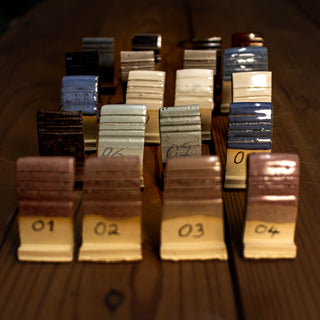The advantages of do-it-yourself: "Glazes in ceramic production"
Producing your own glazes and recipes is time-consuming. It can take several months for a glaze to go from idea to product maturity. This is probably also the reason people often look a bit startled, when we tell them, that all of our glazes come from our own production. Anyone familiar with the huge range of ready-made glazes available for sale could quickly come to the conclusion that this effort is completely unnecessary. Why we nevertheless use exclusively our own glazes, we tell in this article.
Creativity and control
If you make your own glazes, you have control over the color, consistency and texture of the glaze. It doesn't matter whether you adapt existing recipes or develop new glazes right away. What is certain is that you will achieve unique results that are different from the work of other ceramists.
Save costs
Making glazes yourself saves money compared to buying ready-made glazes. Although an initial investment in materials and equipment is required, the potential long-term savings are enormous. If you make ceramics on a regular basis, you can purchase your materials in bulk, reducing your costs.
Sustainability
Making your own glazes can be more environmentally friendly. On the small scale of your own workshop, glaze production can be much more controlled than in a factory. Of course, it takes a certain amount of care in handling raw materials to be truly sustainable.
Precision and reproducibility
For the major glaze manufacturers, it makes sense to adjust glaze formulations to raw material prices. So it can happen that a glaze that has worked for years suddenly reacts differently. That's annoying when you're in the middle of a job. If you buy your raw materials yourself, you may have to accept a higher price in case of shortages, but at least you can rely on the result.
Health hazard
Glazes can contain toxic substances such as heavy metals. Those who have experience in developing glazes can usually assess from the recipe whether the glaze is suitable for tableware or not. However, there is no declaration obligation for purchased glazes. Information about the exact composition of a purchased glaze is therefore rarely available. Packaging information such as "suitable for tableware" or "food-safe" usually only means that no lead or cadmium has been added. This is because raw glazes do not have to be tested by law. Only the manufacturer of utility ceramics needs a certificate of conformity, not the glaze manufacturer. We have tested a number of glazes in recent years. It was not uncommon for us to see that glazes sold as "suitable for tableware" survived only a few minutes in a vinegar bath.
Conclusion
Having your own glaze is not only a unique selling point. Sustainability, reliability and the cost factor are also arguments why it can be worthwhile in the long term to produce glazes.
In our opinion, however, the most important aspect is the danger that glazes can pose. When manufacturing tableware, it is essential for us to use glazes that we produce ourselves. We know exactly what is contained in our glazes

